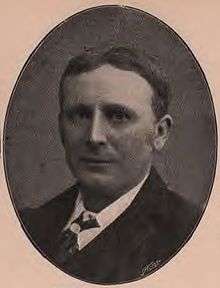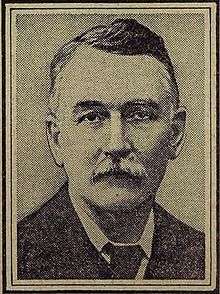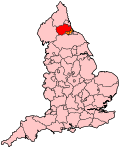North West Durham (UK Parliament constituency)
| North West Durham | |
|---|---|
|
County constituency for the House of Commons | |
|
Boundary of North West Durham in County Durham. | |
|
Location of County Durham within England. | |
| County | County Durham |
| Electorate | 72,760 (December 2010)[1] |
| Major settlements | Consett, Crook, Lanchester and Willington |
| Current constituency | |
| Created | 1950 |
| Member of parliament | Laura Pidcock (Labour) |
| Number of members | One |
| Created from | Barnard Castle, Consett, and Spennymoor |
| 1885–1918 | |
| Number of members | One |
| Type of constituency | County constituency |
| Replaced by | Consett and Barnard Castle |
| Created from |
South Durham North Durham |
| Overlaps | |
| European Parliament constituency | North East England |
North West Durham is a constituency[n 1] represented in the House of Commons of the UK Parliament since 2017 by Laura Pidcock of the Labour Party.[n 2]
History
- 1885–1918
A first incarnation of the seat occurred under the Redistribution of Seats Act 1885 however this was abolished in 1918 to create Consett and to enlarge, using its Weardale part, Barnard Castle. During the first creation Liberals represented the area and its first member until 1914 was the son of a prominent Chartist, Ernest Jones, and helped to promote New Liberalism, encouraging the Liberal Party to take on instead the politics of "mass working-class" appeal. This politics was epitomised by David Lloyd George whose People's Budget, 1909 led to the supremacy of the House of Commons over the House of Lords, national pensions under a barebones welfare state (without a National Health Service).
- 1950–present
On its recreation in 1950 North-West Durham became the successor to Barnard Castle save for the town of that name and its immediate vicinity which instead joined the Bishop Auckland seat. Consett was abolished in 1983 having seen a gradual decline in population in the latter half of its years, and its area was added to North West Durham that year. Throughout this second creation the seat has been represented in Westminster by members of the Labour Party.
Both the current Conservative Party leader and Prime Minister, Theresa May, and the current Liberal Democrat leader, Tim Farron, were their party's candidate for the seat at the 1992 general election, which both of them lost to incumbent Labour MP Hilary Armstrong.
Boundaries

1950–1974: The Urban Districts of Brandon and Byshottles, Crook and Willington, and Tow Law, and the Rural Districts of Lanchester and Weardale.
1974–1983: The Urban Districts of Brandon and Byshottles, Crook and Willington, Spennymoor, and Tow Law, the Rural Districts of Lanchester and Weardale, and the civil parish of Brancepeth in the Rural District of Durham.
1983–1997: The District of Derwentside wards of Benfieldside, Blackhill, Burnhope, Burnopfield, Castleside, Consett North, Consett South, Cornsay, Crookhall, Delves Lane, Ebchester and Medomsley, Esh, Lanchester, and Leadgate, and the District of Wear Valley wards of Crook North, Crook South, Howden, Hunwick, St John's Chapel, Stanhope, Stanley, Tow Law, Wheatbottom and Helmington Row, Willington East, Willington West, and Wolsingham.
1997–2010: The District of Derwentside wards of Benfieldside, Blackhill, Burnhope, Burnopfield, Castleside, Consett North, Consett South, Cornsay, Crookhall, Delves Lane, Dipton, Ebchester and Medomsley, Esh, Lanchester, and Leadgate, and the District of Wear Valley wards of Crook North, Crook South, Howden, Hunwick, St John's Chapel, Stanhope, Stanley, Tow Law, Wheatbottom and Helmington Row, Willington East, Willington West, and Wolsingham.
2010–present: The District of Derwentside wards of Benfieldside, Blackhill, Burnhope, Burnopfield, Castleside, Consett East, Consett North, Consett South, Cornsay, Delves Lane, Dipton, Ebchester and Medomsley, Esh, Lanchester, and Leadgate, and the District of Wear Valley wards of Crook North, Crook South, Howden, Hunwick, St John's Chapel, Stanhope, Tow Law and Stanley, Wheatbottom and Helmington Row, Willington Central, Willington West End, Wolsingham, and Witton-le-Wear.[2]
The constituency is in the north west of County Durham, in the North East England region. When it was created in 1885 it centred on two main communities, Consett and Lanchester.
It currently consists of the western part of the former Derwentside district (including Consett and Lanchester) and the northern part of the former Wear Valley district (including Weardale, Crook and Willington).
Constituency profile
For many years the area gave large majorities suggesting a safe seat for the Labour Party; the majority of the electorate live in former mining or steel towns, where Labour traditionally have polled higher than other parties with the remainder in rural farms and villages throughout valleys cleft from the eastern, rocky part of the Pennines. The current MP is Laura Pidcock, elected at the 2017 general election. Prior to 2017 the constituency was served bt Pat Glass however in the wake of the Brexit referendum, she announced her intention to step down at the next general election, which was announced in April 2017.
Members of Parliament
MPs 1885–1918

| Election | Member[3] | Party | |
|---|---|---|---|
| 1885 | Llewellyn Archer Atherley-Jones | Liberal | |
| 1914 | Aneurin Williams | Liberal | |
| 1918 | Constituency abolished | ||
MPs since 1950
| Election | Member[3] | Party | |
|---|---|---|---|
| 1950 | Constituency recreated | ||
| 1950 | James Murray | Labour | |
| 1955 | William Ainsley | Labour | |
| 1964 | Ernest Armstrong | Labour | |
| 1987 | Hilary Armstrong | Labour | |
| 2010 | Pat Glass | Labour | |
| 2017 | Laura Pidcock | Labour | |
Elections
Elections in the 2010s
| Party | Candidate | Votes | % | ± | |
|---|---|---|---|---|---|
| Labour | Laura Pidcock[5] | 25,308 | 52.8 | +6.0 | |
| Conservative | Sally-Ann Hart[5] | 16,516 | 34.5 | +11.1 | |
| Liberal Democrat | Owen Temple[5] | 3,398 | 7.1 | -2.0 | |
| UKIP | Alan Breeze[5] | 2,150 | 4.5 | -12.5 | |
| Green | Dominic Horsman[5] | 530 | 1.1 | -2.6 | |
| Majority | 8,792 | 18.3 | -5.2 | ||
| Turnout | 47,902 | 66.5 | +5.2 | ||
| Labour hold | Swing | -2.6 | |||
| Party | Candidate | Votes | % | ± | |
|---|---|---|---|---|---|
| Labour | Pat Glass | 20,074 | 46.9 | +4.6 | |
| Conservative | Charlotte Haitham-Taylor | 10,018 | 23.4 | +3.4 | |
| UKIP | Bruce Reid | 7,265 | 17.0 | +14.1 | |
| Liberal Democrat | Owen Temple | 3,894 | 9.1 | -15.8 | |
| Green | Mark Shilcock | 1,567 | 3.7 | N/A | |
| Majority | 10,056 | 23.5 | +6.1 | ||
| Turnout | 42,818 | 61.3 | -0.7 | ||
| Labour hold | Swing | +0.6 | |||
| Party | Candidate | Votes | % | ± | |
|---|---|---|---|---|---|
| Labour | Pat Glass | 18,539 | 42.3 | -11.6 | |
| Liberal Democrat | Owen Temple | 10,927 | 24.9 | +5.0 | |
| Conservative | Michelle Tempest | 8,766 | 20.0 | +3.6 | |
| Independent | Watts Stelling | 2,472 | 5.6 | -4.2 | |
| BNP | Michael Stewart | 1,852 | 4.2 | +4.2 | |
| UKIP | Andrew McDonald | 1,259 | 2.9 | +2.9 | |
| Majority | 7,612 | 17.4 | |||
| Turnout | 43,815 | 62.0 | +4.2 | ||
| Labour hold | Swing | -8.3 | |||
Elections in the 2000s
| Party | Candidate | Votes | % | ± | |
|---|---|---|---|---|---|
| Labour | Hilary Armstrong | 21,312 | 53.9 | -8.6 | |
| Liberal Democrat | Alan Ord | 7,869 | 19.9 | +5.0 | |
| Conservative | Jamie Devlin | 6,463 | 16.4 | -4.5 | |
| Independent | Watts Stelling | 3,865 | 9.8 | +9.8 | |
| Majority | 13,443 | 34.0 | |||
| Turnout | 39,509 | 58.0 | −0.5 | ||
| Labour hold | Swing | −6.8 | |||
| Party | Candidate | Votes | % | ± | |
|---|---|---|---|---|---|
| Labour | Hilary Armstrong | 24,526 | 62.5 | -6.2 | |
| Conservative | William Clouston | 8,193 | 20.9 | +5.6 | |
| Liberal Democrat | Alan Ord | 5,846 | 14.9 | +4.1 | |
| Socialist Labour | Joan Hartnell | 661 | 1.7 | N/A | |
| Majority | 16,333 | 41.6 | |||
| Turnout | 39,226 | 58.5 | -10.2 | ||
| Labour hold | Swing | -5.9 | |||
Elections in the 1990s
| Party | Candidate | Votes | % | ± | |
|---|---|---|---|---|---|
| Labour | Hilary Armstrong | 31,855 | 68.8 | +10.7 | |
| Conservative | Louise St John-Howe | 7,101 | 15.3 | -12.0 | |
| Liberal Democrat | Anthony Gillings | 4,991 | 10.8 | -3.9 | |
| Referendum | Rodney Atkinson | 2,372 | 5.1 | +5.1 | |
| Majority | 24,754 | 53.5 | |||
| Turnout | 46,319 | 68.7 | -6.8 | ||
| Labour hold | Swing | 11.4 | |||
| Party | Candidate | Votes | % | ± | |
|---|---|---|---|---|---|
| Labour | Hilary Armstrong | 26,734 | 57.8 | +6.9 | |
| Conservative | Theresa May | 12,747 | 27.6 | −0.8 | |
| Liberal Democrat | Tim Farron | 6,728 | 14.6 | -6.1 | |
| Majority | 13,987 | 30.2 | +7.7 | ||
| Turnout | 46,209 | 75.5 | +2.0 | ||
| Labour hold | Swing | 3.4 | |||
Elections in the 1980s
| Party | Candidate | Votes | % | ± | |
|---|---|---|---|---|---|
| Labour | Hilary Armstrong | 22,947 | 50.9 | ||
| Conservative | Derek Iceton | 12,785 | 28.36 | ||
| Liberal | Chris Foote Wood | 9,349 | 20.74 | ||
| Majority | 10,162 | 22.54 | |||
| Turnout | 45,081 | 73.54 | |||
| Labour hold | Swing | ||||
| Party | Candidate | Votes | % | ± | |
|---|---|---|---|---|---|
| Labour | Ernest Armstrong | 19,135 | 44.58 | ||
| Conservative | T Middleton | 12,779 | 29.77 | ||
| Liberal | Chris Foote Wood | 11,008 | 25.65 | ||
| Majority | 6,356 | 14.81 | |||
| Turnout | 42,923 | 70.66 | |||
| Labour hold | Swing | ||||
Elections in the 1970s
| Party | Candidate | Votes | % | ± | |
|---|---|---|---|---|---|
| Labour | Ernest Armstrong | 29,525 | 61.3 | ||
| Conservative | T Fenwick | 14,245 | 29.58 | ||
| Liberal | J Hannibell | 4,394 | 9.12 | ||
| Majority | 15,280 | 31.72 | |||
| Turnout | 48,161 | 75.98 | |||
| Labour hold | Swing | ||||
| Party | Candidate | Votes | % | ± | |
|---|---|---|---|---|---|
| Labour | Ernest Armstrong | 27,953 | 64.16 | ||
| Conservative | MJB Cookson | 9,197 | 21.11 | ||
| Liberal | JK Forster | 6,418 | 14.73 | ||
| Majority | 18,756 | 43.05 | |||
| Turnout | 43,566 | 71.09 | |||
| Labour hold | Swing | ||||
| Party | Candidate | Votes | % | ± | |
|---|---|---|---|---|---|
| Labour | Ernest Armstrong | 28,326 | 59.01 | ||
| Conservative | J Riddell | 10,865 | 22.64 | ||
| Liberal | JK Forster | 8,809 | 18.35 | ||
| Majority | 17,461 | 36.38 | |||
| Turnout | 47,999 | 79.09 | |||
| Labour hold | Swing | ||||
| Party | Candidate | Votes | % | ± | |
|---|---|---|---|---|---|
| Labour | Ernest Armstrong | 24,245 | 69.6 | ||
| Conservative | Alan E Page | 10,590 | 30.4 | ||
| Majority | 13,655 | 39.2 | |||
| Turnout | 34,834 | 72.85 | |||
| Labour hold | Swing | ||||
Elections in the 1960s
| Party | Candidate | Votes | % | ± | |
|---|---|---|---|---|---|
| Labour | Ernest Armstrong | 25,260 | 73.58 | ||
| Conservative | Colin MacAndrew | 9,070 | 26.42 | ||
| Majority | 16,190 | 47.16 | |||
| Turnout | 73.37 | ||||
| Labour hold | Swing | ||||
| Party | Candidate | Votes | % | ± | |
|---|---|---|---|---|---|
| Labour | Ernest Armstrong | 26,006 | 69.75 | ||
| Conservative | Kenneth L Ellis | 11,280 | 30.25 | ||
| Majority | 14,726 | 39.49 | |||
| Turnout | 77.98 | ||||
| Labour hold | Swing | ||||
Elections in the 1950s
| Party | Candidate | Votes | % | ± | |
|---|---|---|---|---|---|
| Labour | William Ainsley | 28,064 | 68.06 | ||
| Conservative | Olive Sinclair | 13,172 | 31.94 | ||
| Majority | 14,892 | 36.11 | |||
| Turnout | 81.45 | ||||
| Labour hold | Swing | ||||
| Party | Candidate | Votes | % | ± | |
|---|---|---|---|---|---|
| Labour | William Ainsley | 27,116 | 67.41 | ||
| Conservative | Thomas T Hubble | 13,110 | 32.59 | ||
| Majority | 14,006 | 34.82 | |||
| Turnout | 79.05 | ||||
| Labour hold | Swing | ||||
| Party | Candidate | Votes | % | ± | |
|---|---|---|---|---|---|
| Labour | James Murray | 30,417 | 68.66 | ||
| Conservative | James Quigley | 13,885 | 31.34 | ||
| Majority | 16,532 | 37.32 | |||
| Turnout | 85.06 | ||||
| Labour hold | Swing | ||||
| Party | Candidate | Votes | % | ± | |
|---|---|---|---|---|---|
| Labour | James Murray | 31,084 | 69.67 | ||
| Conservative | James Quigley | 13,530 | 30.33 | ||
| Majority | 17,554 | 39.35 | |||
| Turnout | 86.52 | ||||
| Labour hold | Swing | ||||
Elections in the 1910s

| Party | Candidate | Votes | % | ± | |
|---|---|---|---|---|---|
| Liberal | Aneurin Williams | 7,241 | |||
| Unionist | James Ogden Hardicker | 5,564 | |||
| Labour | G. H. Stuart-Bunning | 5,026 | |||
| Majority | |||||
| Turnout | |||||
| Liberal hold | Swing | ||||

| Party | Candidate | Votes | % | ± | |
|---|---|---|---|---|---|
| Liberal | Llewellyn Atherley-Jones | 8,998 | 65.1 | ||
| Conservative | James Ogden Hardicker | 4,827 | 34.9 | ||
| Majority | 4.171 | 30.2 | |||
| Turnout | 75.3 | ||||
| Liberal hold | Swing | ||||
See also
Notes and references
- Notes
- ↑ A county constituency (for the purposes of election expenses and type of returning officer)
- ↑ As with all constituencies, the constituency elects one Member of Parliament (MP) by the first past the post system of election at least every five years.
- References
- ↑ "Electorate Figures – Boundary Commission for England". 2011 Electorate Figures. Boundary Commission for England. 4 March 2011. Retrieved 13 March 2011.
- ↑ "The Parliamentary Constituencies (England) Order 2007". National Archives. Retrieved 21 June 2016. Theis article contains quotations from this source, which is available under the Open Government Licence v3.0.
- 1 2 Leigh Rayment's Historical List of MPs – Constituencies beginning with "D" (part 4)
- ↑ "Durham North West". BBC News. Retrieved 12 June 2017.
- 1 2 3 4 5 "See which candidates will be standing in your constituency in the General Election". The Northern Echo.
- ↑ "Election Data 2015". Electoral Calculus. Archived from the original on 17 October 2015. Retrieved 17 October 2015.
- ↑ "Durham North West". BBC News. Retrieved 15 May 2015.
- ↑ "Election Data 2010". Electoral Calculus. Archived from the original on 17 October 2015. Retrieved 17 October 2015.
- ↑ http://www.durham.gov.uk/PDFApproved/ParliamentaryElection2010_SoPN_Rev_NWD.pdf
- ↑ "BBC NEWS – Election 2010 – Durham North West". BBC News.
- ↑ "Election Data 2005". Electoral Calculus. Archived from the original on 15 October 2011. Retrieved 18 October 2015.
- ↑ "Election Data 2001". Electoral Calculus. Archived from the original on 15 October 2011. Retrieved 18 October 2015.
- ↑ "Election Data 1997". Electoral Calculus. Archived from the original on 15 October 2011. Retrieved 18 October 2015.
- ↑ "Election Data 1992". Electoral Calculus. Archived from the original on 15 October 2011. Retrieved 18 October 2015.
- ↑ "Politics Resources". Election 1992. Politics Resources. 9 April 1992. Retrieved 2010-12-06.
- ↑ "Election Data 1987". Electoral Calculus. Archived from the original on 15 October 2011. Retrieved 18 October 2015.
- ↑ "Election Data 1983". Electoral Calculus. Archived from the original on 15 October 2011. Retrieved 18 October 2015.
- ↑ "UK General Election results: June 1983 [Archive]". www.politicsresources.net.
- ↑ "UK General Election results: May 1979 [Archive]". www.politicsresources.net.
- ↑ "UK General Election results: October 1974 [Archive]". www.politicsresources.net.
- ↑ "UK General Election results: February 1974 [Archive]". www.politicsresources.net.
- ↑ "UK General Election results 1970 [Archive]". www.politicsresources.net.

